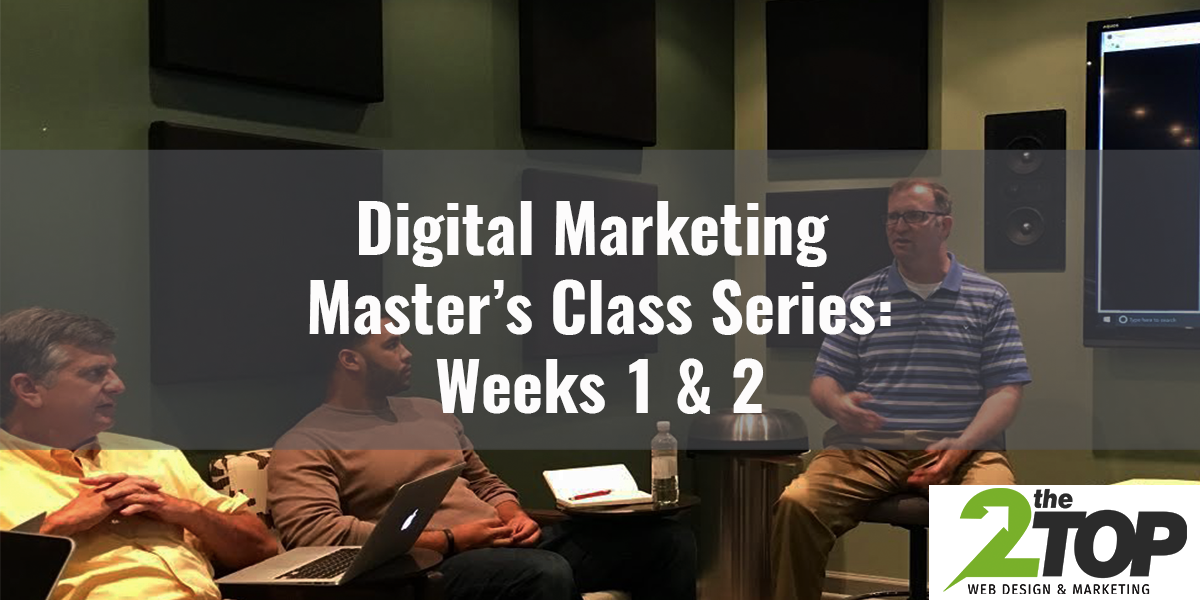
Welcome to the weekly Digital Marketing Master’s Class Blog Series. My name is Riley Duncan, and I am a Digital Marketing Specialist for 2 the Top. I am very excited to be a part of the 2017 Summer Digital Marketing Master’s Class, where I will participate in all class activities as well as document the class through social media and this blog. The class runs for 14 weeks on Tuesday nights from 6 – 9 p.m. This is the first post in the series.
WEEK 1: Class Introductions
This summer’s class kicked off on Tuesday, May 23 in our East Nashville office. Our class of 14 students went around the room, introducing ourselves and explaining why we were taking Ross’s class.
Some classmates are marketers, looking to expand their knowledge and do their jobs more effectively. Others are entrepreneurs, looking to grow their business through Internet marketing. All of us, though, are excited to learn more about digital marketing each week and put what we learn into practice.
Because it was the first week, much of the class was spent getting familiar with the syllabus, the office, and the format of the class. After introductions and a tour of our Center 615 office, we received our first homework assignment, which was to read Chapters 1 and 2 in our textbook and take the accompanying quizzes.
WEEK 2: Foundations of Internet Marketing & Search Engines
To start class the following week, we reviewed Chapter 1 in the textbook.
Chapter 1 covers Internet Marketing Foundations, which includes:
- Technical terms related to digital marketing, such as URL, IP address, cookies, servers, client-side vs. server-side, and transport layer security (TLS).
- What goes into a successful website
- The different types of traffic to a website
- How to measure conversions
Enjoyed covering the foundations of Internet Marketing during the second week of our Digital Marketing Master’s Class last night! pic.twitter.com/6ZKfqpxe15
— Ross Jones (@2theTopDesign) May 31, 2017
We spent time diving into these topics in class. Ross split the room into two groups that would each analyze a website. We were given three criteria to consider: traffic, conversions, and revenue. The point of this exercise was to see how different websites with different objectives were set up.
My group was instructed to take a look at NYTimes.com, while the other group was assigned ESPN.com. Each group spent about 10 minutes before presenting our findings to the class.
This concluded our lesson on Chapter 1, and we took a short break before diving into the next chapter.
Chapter 2 of the textbook covers How Search Engines work, which includes
- The History of Search Engines
- Google Search Algorithm
- Google Updates
Ross spent some time explaining PageRank – named after Google co-founder Larry Page. He explained the importance of both authority and relevance as far as ranking well in search engines.
We got into a discussion about meta keywords as well, which are NOT a ranking factor used by Google. Many classmates asked questions, and by the end of it, it seemed as though everyone had a solid understanding of how search engines operate.
After the discussion, we received our homework assignments, reading the next two chapters about On-Site and Off-Site SEO, as well as leaving a Yelp review by next class.
Everyone seems very excited to dig into SEO next week.
Make sure to follow us on Facebook and Twitter for live updates, and I’ll post another blog in a couple weeks!
